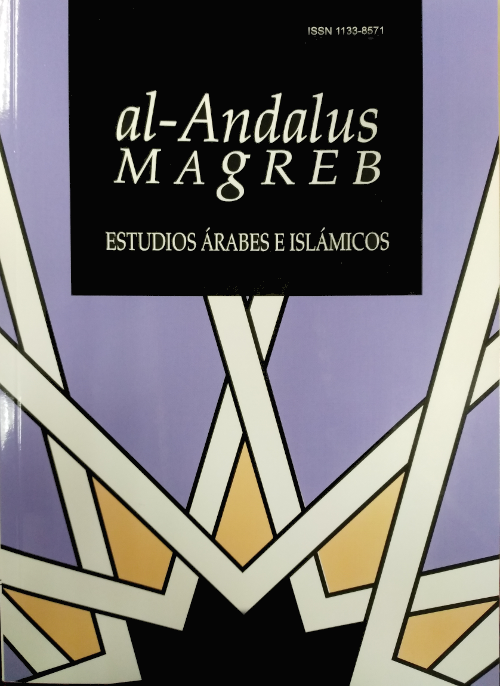Some Observations on the Poetical Language of Love Songs in the Dialect of the Jbala (Northern Morocco)

Información
Resumen
Este artículo trata sobre canciones populares de temática amorosa en dialecto árabe yebalí. Para ello, nos serviremos de material adicional extraído de algunos dialectos árabes. Se mostrará cómo los motivos y situaciones, al igual que el léxico, comunes a este tipo de poesía, son idénticos a los empleados en composiciones de otros dialectos árabes.
Palabras clave
Descargas
Cómo citar
Licencia

Esta obra está bajo una licencia internacional Creative Commons Atribución-NoComercial-SinDerivadas 4.0.
Aquellos autores/as que tengan publicaciones con esta revista, aceptan los términos siguientes:
- Los autores/as podrán conservar sus derechos de autor y garantizarán a la revista el derecho de primera publicación de su obra, el cuál estará simultáneamente sujeto a la Licencia de reconocimiento de Creative Commons que permite a terceros compartir la obra siempre que se indique su autor y su primera publicación esta revista.
- Los autores/as podrán adoptar otros acuerdos de licencia no exclusiva de distribución de la versión de la obra publicada (p. ej.: depositarla en un archivo telemático institucional) siempre que se indique la publicación inicial en esta revista.
- Se permite y recomienda a los autores/as difundir su obra a través de Internet (p. ej.: en archivos telemáticos institucionales o en su página web) una vez el manuscrito sea aceptado, lo cual puede producir intercambios interesantes y aumentar las citas de la obra publicada. (Véase El efecto del acceso abierto).
Citas
ABU-HAIDAR, Farida 1995. “The linguistic content of Iraqi popular songs.” Studia Orientalia 75:9-24. Helsinki.
ABU-LUGHOD, Lila 1995. “Honor and the Sentiments of Loss in a Bedouin Society”. American Ethnologist 12: 245-61.
AYDOUN, Ahmed 1995. Musiques du Maroc. Casablanca.
BIARNAY, Simon 1924. Enthnographie et linguistique Nord-Africaines. Paris. CHOTTIN, Alexis 1940. Tableau de la Musique Marocaine. Geuthner, Paris. CURTIS, Maria 2001. “Multiple Meanings of “Voice” in ‘Ayoua: Gender,
Improvisation, and Self in the Recording Studio”. Text, Practice, Performance III: 127-146. Américo Paredes Center for Cultural Studies at the UTA.
FROLOVA, Olga 1984. Poeticheskaya leksika arabskoy liriki. Leningrad State University.
FROLOVA, Olga 1971. “Sbornik Egipetskih Narodnih Pesen”. Voprosi filologii stran Azii I Afriki, I: 125 - 132. Leningrad State University.
HARRELL, Richard S. 1966. A Dictionary on Moroccan Arabic. Georgetown University Press, Washington, DC.
HARRELL, Richard S. 2004. A Short Refference Grammar of Moroccan Arabic. Georgetown University Press.
JARGY, Simon 1970. La poésie populaire traditionnelle chantée au Proche- Orient Arabe. I Les textes. Paris/La Haye.
KURPERSHOEK, Marcel P. 1994. Oral Poetry and Narratives from Central Arabia. Vol. I. The Poetry of Ad-Dindan A Bedouin Bard in Southern Najd. Leiden.
LANE, E. W. 1989. Manners and Customs of the Modern Egyptians. London. MAGHNIA, A. & KHARCHAFI, A. 2000. La taqtuqa jabaliya: ‘ayta du Nord du Maroc. Horizons Maghrebins 43:22-24. Presses Universitaires du
Mirail.
MICHAUX-BELLAIRE, Eugene 1911. Quelques tribus de montagne de la
région du Habt. Archives Marocaines. Vol. XVII. Paris.
MOULIÉRAS, Auguste 1899. Le Maroc Inconnu, deuxiéme partie: Exploration
des Djebala (Maroc Septentrional). Paris.
NAMIR, Abdelkabir 2005, September 06. L'Aïta réhabilitée. Le matin.Retrieved December 20, 2005 from http://www.lematin.ma/journal/
article.asp?id=artcu&ida=51814.
SALMON, George 1904. Une tribu marocaine: les FaÑçya. Archives Marocaines I: 149-261. Paris.
AUDIOCASSETTE MATERIAL
Mohamed Laâroussi, reggebt ‘ala ‘ayn z...ra. Fes Maatic, Fes, z. Indus. - Sidi Brahim 814 No 39.
el-Ñaîî MoÑammed La‘r–si, ∑na b∑li ma‘a éz∑li. Fes Maatic, Fes, z. Indus. - Sidi Brahim 814 No 39.
Mohammed Laâroussi, r∑îli huwa Ü∑lem. Fes Maatic, Fes, z. Indus. - Sidi Brahim 814 No 39.
Sahra ma‘a awl∑d La‘r–si (songs by Mohamed Laâroussi are Nos 6 and 7). Fassiphone, Fes, Belgium SPRL 59 rue des Palais 1030 Bruxelles (Belgique).


